
- Ancient Rome
- Medieval England
- Stuart England
- World War One
- World War Two
- Modern World History
- Philippines
- History Learning >
- History of the Philippines >
- Colonial >
- Magellan's Expedition
Ferdinand Magellan was a Portuguese explorer who was determined to reach India and the East Indies by a new route - under the southern end of America. His journey to the Philippines is believed to have been the first documented European expedition to the archipelago. Born into a family of nobility in Portugal, and despite being in the service of the Portuguese crown in Asia, Magellan did not support for his plans from King Manuel I of Portugal and he was eventually selected by King Charles I of Spain to search for a new route to the Maluku Islands. Ferdinand was given command of a fleet of five vessels and set off on a journey around South America, travelling through the Atlantic Ocean to Patagonia and onto the Pacific Ocean. By 1521, the fleet reached the Spice Islands and soon began their journey home in a bid to complete the first circuit of the globe. During their return journey, the ships sailing under Magellan sighted the mountains of Samar at dawn on 17th March 1521, before making landfall the following day in the island of Homonhon. On Easter Sunday, 31st March 1521, Magellan planted a cross on the summit of a hill that overlooked the sea, claiming the islands he had seen in the name of the king of Spain and naming them Archipelago of Saint Lazarus.
Magellan went on to seek alliances with the indigenous Filipinos, beginning with the chieftain of Sugbu (now Cebu) - Datu Zula. In fact, he took great pride in converting the local people to Catholicism and even became heavily involved with ongoing political rivalries between the local Cebuano natives. This interference eventually led to Magellan’s involvement in the battle of the Cebuano natives against Lapu-Lapu, who was the chieftain of Mactan Island and enemy of Datu Zula. As the sun rose on 27th April 1521, Magellan launched an invasion of Mactan Island with 60 armed men and 1,00 warriors from Cebu, but landing on the rocky shores proved difficult. In response to the conditions, Magellan ordered Datu Zula and his men to stay aboard the ships while he and his soldiers take care of the Lapu-Lapu army. However, the Mactan defenders had been seriously underestimated, with 1,500 present along the shoreline. Magellan and his soldiers were attacked and he was killed, along with 14 of his men. The remaining soldiers managed to reboard the ships before escaping back to Cebu. As a result of Magellan’s death, claims on Spice Islands were eventually relinquished to Portugal as part of the treaty of Zaragoza. However, the treaty didn’t stop the Philippines from being colonised by the Spanish in the future when additional additional expeditions were dispatched to the islands.

MLA Citation/Reference
"Magellan's Expedition". HistoryLearning.com. 2024. Web.
Related Pages

The Ages of Exploration
Ferdinand magellan, age of discovery.
Quick Facts:
He led the first circumnavigation of the world, and is considered the first European to cross the Pacific Ocean
Name : Ferdinand Magellan [fur-dn-and] [muh-jel-uhn]
Birth/Death : 1480-1521
Nationality : Portuguese
Birthplace : Porto or Sabrosa, Portugal
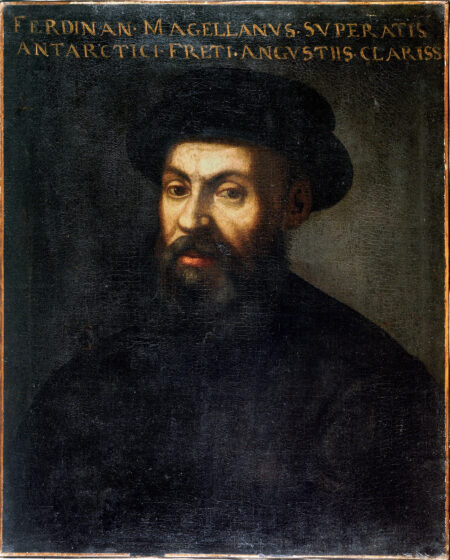
Portrait of Ferdinand Magellan
Half-length portrait of Ferdinand Magellan (circa 1580-1521), first European to circle the globe. The Mariners Museum 1949.0619.000001
Introduction Ferdinand Magellan is known for circumnavigating – sailing around – the world. From Spain he sailed around South America, discovering the Strait of Magellan, and across the Pacific. Though he was killed in the Philippines, his ship the Victoria continued westward to Spain, accomplishing the first circumnavigation of the globe. But in some cases, his journey was filled with more than he would bargain for. Magellan’s story is filled with war, storms, mutiny, and hostile native encounters.
Biography Early Life Ferdinand Magellan was born in 1480 in Portugal; the exact city is unknown. Many believe it was either Porto or Sabrosa. Ferdinand Magellan is the English version of his name. In Portuguese, his name is Fernão de Magalhães. He came from a noble family. His father was Rui de Magalhães and Alda de Mesquita. Young Magellan was a page in the royal court for the queen of Portugal. Here, he would learn helpful skills such as hunting, fighting, and he would have learned about the stars. 1 His father often traveled to a town called Oporto (also spelled Porto). The harbor here was crowded with shipping and seafaring travelers with tales of adventure. It is possible that Oporto is where Magellan found a love for the sea and exploration. 2 But Ferdinand Magellan was not always an explorer. He began his career as a soldier in the Portuguese navy. He left Portugal in 1505 and sailed to India under the command of Francisco de Almeida. They were sent by King Manuel I to break Muslim sea power in India and Africa. 3 Magellan left Lisbon on March 25, 1505. He would travel and fight in several battles over the next few years.
In 1506, Magellan traveled to the East Indies (modern day Indonesia) and joined expeditions to Spice Islands (also called the Molucca Islands). In February 1509, he took part in the naval Battle of Diu, which marked the decline of Ottoman (modern day Turkey) influence in the area. The Portuguese now had dominance over most of the Indian Ocean. He returned to Lisbon in 1512. A year later, he went to Morocco in Northern Africa where he fought in another battle. During the battle, Magellan received a serious wound that would cause him to walk with a limp for the rest of his life. 4 Also while in Morocco, Magellan was accused of stealing. He was proven innocent, but the incident ruined his reputation with the Portuguese king. Magellan wanted to command a voyage to the Spice Islands. He believed he could reach them by sailing west. When he returned to Portugal, he petitioned King Manuel I three times to let him go. The King refused each time. Ferdinand Magellan then went to King Charles I of Spain. The Spanish King agreed to sponsor what would become Magellan’s great voyage around the world.
Voyages Principal Voyage By the end of October 1517, Magellan was in Seville, becoming a Spanish citizen. King Charles I funded Magellan and he set sail September 20, 1519 with a fleet of five ships and roughly 200 men. The five ships were: the Trinidad , captained by Magellan; San Antonio , captained by Juan de Cartagena; Concepción , captained by Gaspar de Quesada; Victoria , captained by Luis de Mendoza; and the Santiago , captained by Juan Serrano. They stopped at the Canary Islands to pick up some supplies, and then continued into the Atlantic Ocean. Magellan received a letter that the Spanish officers planned to kill him after leaving the Canaries. Magellan remained on guard for his life throughout much of the trip. They sailed for several weeks, and by November 20, they crossed the equator into the southern hemisphere. 5 In December, they stopped at Guanabara Bay in southeastern Brazil to resupply once again.
Magellan’s fleet continued on down the coast of South America. He was searching for a passage that connected one ocean to the other. As their journey went on, life at sea became difficult. Food and water became rationed, and the crew was not happy. On April 1, 1520, while at Port St. Julian, the three captains Cartagena, Mendoza, and Quesada called their crews to mutiny. 6 The mutiny was crushed by Magellan. Mendoza had been killed during the mutiny. Quesada and Cartagena were found guilty of murder and treason. Quesada was beheaded for his crime, while Cartagena was left marooned – or stranded – on land when the fleet left. 7 The fleet traveled onward. While near Santa Cruz, the Santiago wrecked while on a scouting mission. They continued south and on October 21, 1520 he finally found the passage they were searching for. Shortly after entering the passage, the San Antonio deserted the mission. On November 8, 1520 the Trinidad , Concepción , and Victoria reached the “Sea of the South.” 8 Today we know it as the Pacific Ocean. This passage at the tip of South America that Ferdinand Magellan had found would later be renamed the Strait of Magellan.
Subsequent Voyages Ferdinand Magellan had problems along the way, but he had finally reached the Pacific Ocean. Once through the strait, Magellan continued northward up the coast of Chile. In March the reached the island we now know as Guam. Here, they found and ate fresh food for the first time in 99 days. 9 Having found a route through South America, Magellan was still determined to reach the Spice Islands. He and his fleet continued west. Along their course, they noticed a constant flow of wind. This air provided steady winds to their back which was very helpful to their sailing. Magellan and his crew had unknowingly discovered “trade winds.” The name would come from the important role they would later play in transoceanic trade. Their journey continued until they reached the Philippines in March of 1521. By this point, Magellan had endured a somewhat difficult yet successful journey. But his luck would not last much longer.
Later Years and Death Throughout the Philippine Islands, Magellan and his men regularly interacted with the natives. At Cebú, The native chief, his wife, and several of the natives were baptized and converted to Christianity. Because of this, Magellan thought he could convince other native tribes to convert. But not all interactions with the natives were friendly. Chief Datu Lapu Lapu of the Mactan Island rejected conversion. So Magellan took a group of about 60 men to attack Mactan. The Mactan’s had about 1500 men. On April 27, 1521, Ferdinand Magellan was killed during battle on the Philippine Islands. The Trinidad and Victoria soon made it to the Spice Islands. The Trinidad needed much repair. So the Victoria , captained by Juan Sebastian Elcano continued on.On December 21,1521, the Victoria sailed across the Indian Ocean to Spain. September 6, 1522, they arrived with only 18 men at Sanlúcar de Barrameda on the coast of Spain.
Legacy Although he died in the Philippines, we recognize Ferdinand Magellan as the first European to circumnavigate the globe. He fearlessly commanded a fleet of ships, one that completed the journey in his name and honor. Several discoveries were made along the way. The Strait of Magellan, off the southern coast of South America, became an important navigational route. His discovery of the trade winds ranks among his most useful and major findings. 10 The expedition gave Europeans a much better understanding of the extent of the Earth’s size. Much of what we know of Magellan’s journey came from Antonio Pigafetta. A crew member of the famed voyage, Pigafetta kept a first hand account of the voyage. He and his story survived the journey around the globe, and his account later was translated. Magellan had set out with a goal to discover a Western sea route to the Spice Islands. What he helped prove, however, is that the world is indeed round, and much bigger than Europeans previously imagined.
- Mervyn D. Kaufman, Ferdinand Magellan (Mankato: Capstone Press, 2004), 6.
- Frederick Albion Ober, Ferdinand Magellan (New York: Harper & Brothers Publishers, 1907), 5 – 6.
- Britannica Educational Publishing, The Britannica Guide to Explorers and Explorations That Changed the Modern World (New York: Britannica Educational Publishing, 2010), 77.
- Michael Burgan, Magellan: Ferdinand Magellan and the First Trip Around the World (Mankato: Capstone Publishers, 2001), 11.
- Nancy Smiler Levinson, Magellan and the First Voyage Around the World (New York: Clarion Books, 2001), 55.
- Ober, Ferdinand Magellan , 143 – 148.
- Ober, Ferdinand Magellan , 151 – 153.
- Britannica Educational Publishing, The Britannica Guide , 81.
- Laurence Bergreen, Magellan: Over the Edge of the World (New York: Roaring Brook Press, 2017), 89.
Bibliography
Bergreen, Laurence. Magellan: Over the Edge of the World . New York: Roaring Brook Press, 2017.
Britannica Educational Publishing. The Britannica Guide to Explorers and Explorations That Changed the Modern World . New York: Britannica Educational Publishing, 2010.
Burgan, Michael. Magellan: Ferdinand Magellan and the First Trip Around the World . Mankato: Capstone Publishers, 2001.
Kaufman, Mervyn D. Ferdinand Magellan . Mankato: Capstone Press, 2004.
Levinson, Nancy Smiler. Magellan and the First Voyage Around the World . New York: Clarion Books, 2001.
Ober, Frederick Albion. Ferdinand Magellan . New York: Harper & Brothers Publishers, 1907.

- Original "EXPLORATION through the AGES" site
- The Mariners' Educational Programs


Oxford University Press's Academic Insights for the Thinking World
Magellan reaches the Philippines
- March 16 th 2012
This Day in World History
March 16, 1521, magellan reaches the philippines.
The expedition of five ships and 250 men had left Spain on September 20, 1519. Magellan sought a western route — avoiding the southern tip of Africa, which Portugal controlled — to the Spice Islands (the Moluccas) of Southeast Asia. Magellan survived two mutinies before sailing around the southern tip of South America, finding the strait named for him , in November of 1520. Reaching calm waters after a dangerous passage, Magellan named the ocean west of South America “the Pacific Ocean.”
As the ships continued sailing west, supplies dwindled, the crew was forced to eat leather and drink a mixture of salt and freshwater, and men began dying of scurvy . Fortified by provisions secured at island stops along the way, the ships reached the Philippines in March 1521.
Magellan spent more than a month in the area, trading with local leaders and trying to convert them to Christianity. He grew angry at one chief who refused to cooperate, however, and ordered an attack on his village. Wounded in the fighting, Magellan bravely held his ground while the rest of his men escaped back to the ship, but then received more wounds and died on the beach.
It took until September of 1522 for the remains of the expedition, 17 survivors under the command of Juan Sebastián de Elcano , to reach Spain. Though he did not complete this voyage, Magellan is considered the first person to circumnavigate the globe because earlier in his career he had sailed an eastern route from Portugal to Southeast Asia, the same region he had reached on his last, fatal voyage by sailing west.
“This Day in World History” is brought to you by USA Higher Education . You can subscribe to these posts via RSS or receive them by email .

- This Day in History
Our Privacy Policy sets out how Oxford University Press handles your personal information, and your rights to object to your personal information being used for marketing to you or being processed as part of our business activities.
We will only use your personal information to register you for OUPblog articles.
Or subscribe to articles in the subject area by email or RSS
Related posts:

Recent Comments
Would it have been too much trouble to name the local chief Lapu-Lapu, the Philippines’ first hero against European aggression? Also, the article makes it sound like Magellan died valiantly, when in reality he manipulated one chieftain against another, and died because he underestimated the strength of Lapu-Lapu’s forces.
When shall we celebrate Lapulapu day and when shall we declare Lapulapu a hero? Wait till Rodrigo Roa will become president ‘coz he was born in Maasin?
Conquerors always record their exploits in their favor. They project the good side of their conquest but the means n ways are kept under wraps. History belongs to those victorious in their mission . My interpretation of magellan’s encounter with Lapu-lapu is that of a typical conquistador forcing his way to the locals feeling God almighty. Imagine some alien walking straight to your backyard and claiming outright ownership using religion as platform to gain support and sympathy. Too bad , Lapu-lapu was one bad ass chief that cant be fooled.
when did Magellan first shared food with cebuanos? much like native americans, I’m curious as to when are filipinos will celebrate thanksgiving day.
What did he find though I need to do a project for school and I’ve learned nothing about what I searched
MAGELLAN WAS KILLED BY THEIR CHIEF LAPU-LAPU
This is how historians recorded/ presented documents. It is still covering it’s true details. Blinded the efforts of true heroes
Philippines called The Kingdom of Maharlika before the Spanish claimed it under by King Philip. It was Civilized before they discover it. The history are wrote in the “Ang Aklatan” Discovered by Elisha M. Enoc and he is an Archeology
Why did magellan come to mactan?
Thank you for the knowledge about the PHILIPPINES history during spanish regim long time ago
I’m reading Genghis Khan and the making of the Modern World this was the reason I ended up on this sight. Should the Mongols were successful in occupying Japan and Java, the Mongols would have been 300 years earlier from Magellan as what historians put it into word discovered. They also claimed to the reasons of Magellan’s expedition to the Pacific is to proved that the world is round as Christians they should have known that. The Bible says it in Noah’s Ark. Well not explicitly, though.
Why did Magellan sailed west not east to reach the Philippines?
Magellan “accidentally” went to the Philippines but their main goal is to trade with the people in Moluccas or the Spice Islands. The product that the Spaniards are aiming for is the spices like nutmeg.
That’s Lapu-Lapu, the chief who did not cooperate and fight for the Philippines’ religious freedom, one of the Philippines bravest heroes. I just dont understand why people are greedy and does’nt have contentment on what they have and wanting to colonized other country. Its not like you’re going to bring all the lands,money, and power to the afterlife when you die.
Why is he said to be ‘brave’ in standing ground after he attacked a village? I hope those people celebrate how they victoriously defended their village from the Spanish invaders. #decolonisenow
Also remember that even Magellan died because of what he do in native people he always the person who introduced the Christianity that until know our beloved brother and sister christian believe .
Comments are closed.
HISTORIC ARTICLE
Apr 27, 1521 ce: magellan killed in philippine skirmish.
On April 27, 1521, explorer Ferdinand Magellan was killed in a skirmish among rival tribes in the Philippines.
Anthropology, Social Studies, World History
Loading ...
On April 27, 1521, Portuguese explorer Ferdinand Magellan was killed by a poison arrow during a skirmish on the island of Mactan in what is now the Philippines. Magellan and his crew were assisting a local king they had allied with when they landed on the island of Cebu weeks earlier. Magellan and his crew endured a long voyage to the Philippines. First, they sailed from Spain to the Canary Islands off the coast of West Africa. From there, they crossed the Atlantic Ocean to what is now Brazil and Argentina. The harrowing trip around the tip of South America—what is now called the Strait of Magellan—took 38 days. Then the crew set sail across the Pacific. By the time Magellan and his crew reached the Philippines, they had been at sea for more than a year. Magellan was on a route to Portuguese territories in the Spice Islands (now Indonesia). Although Magellan himself was Portuguese, he was working for Spain, and hoped to claim the lucrative islands for the Spanish Empire.
Media Credits
The audio, illustrations, photos, and videos are credited beneath the media asset, except for promotional images, which generally link to another page that contains the media credit. The Rights Holder for media is the person or group credited.
Last Updated
October 19, 2023
User Permissions
For information on user permissions, please read our Terms of Service. If you have questions about how to cite anything on our website in your project or classroom presentation, please contact your teacher. They will best know the preferred format. When you reach out to them, you will need the page title, URL, and the date you accessed the resource.
If a media asset is downloadable, a download button appears in the corner of the media viewer. If no button appears, you cannot download or save the media.
Text on this page is printable and can be used according to our Terms of Service .
Interactives
Any interactives on this page can only be played while you are visiting our website. You cannot download interactives.
Related Resources
Ohio State nav bar
The Ohio State University website
- BuckeyeLink
- Find People
- Search Ohio State

Magellan’s Circumnavigation of the Earth
- Dani Anthony
On September 20, 1519, five ships carrying about 270 men left the Spanish port of Sanlúcar de Barrameda sailing west — and kept going. Led by explorer Ferdinand Magellan, the armada’s goal was to reach the Spice Islands of Maluku (in the Indonesian archipelago) and open a new trading route for Spain.
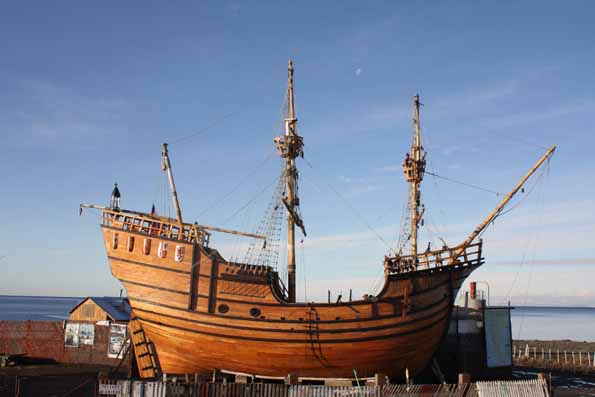
Thus began the first recorded trip around the globe. An almost unimaginably difficult and perilous journey for the crew, Magellan’s voyage was the opening chapter in the rise of global trade and globalization that defines our world today. It also generated important scientific knowledge, including more information about the earth’s circumference and new understandings of global time.
Establishing this new western sailing route was vital to Spain’s future as an international power. In 1494, after Christopher Columbus returned from the West Indies, the Spanish and Portuguese governments signed a deal known as the Treaty of Tordesillas in which the world was divided into two halves: Portugal could colonize and develop trade with Africa, Asia, and the East Indies, while Spain controlled the Americas. By 1515, then, the only way for Spain to access the luxury goods available in the Spice Islands and elsewhere in Asia was via a westward route.
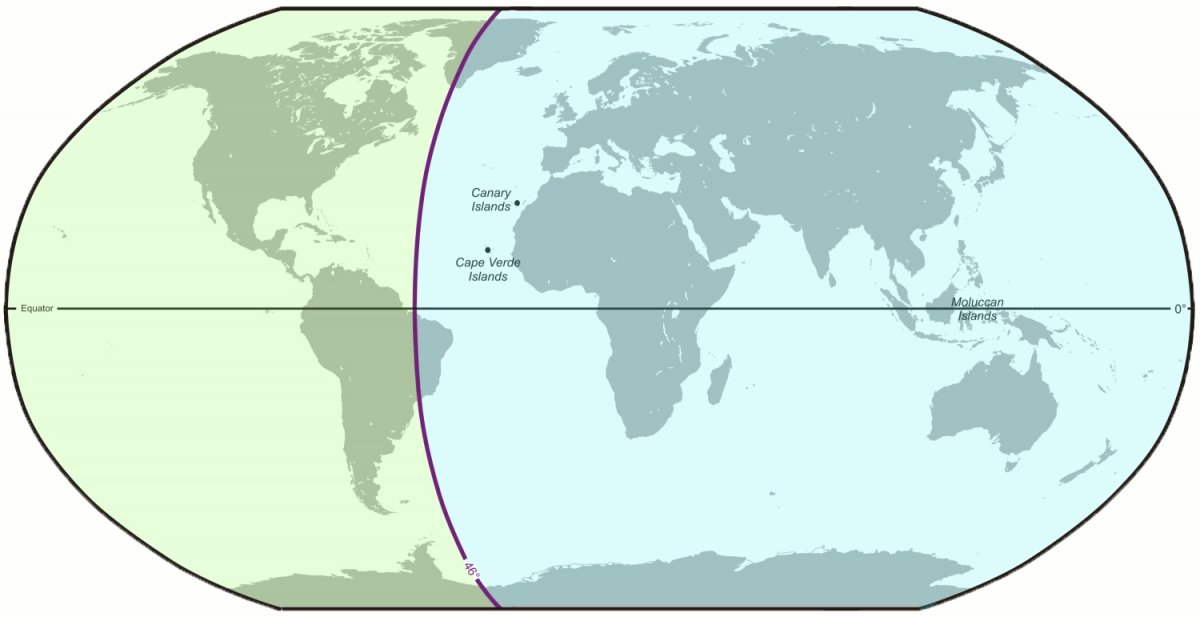
A map showing the demarcation line between Spanish (green) and Portuguese (blue) claims, as resolved in the Treaty of Tordesillas.
It was at this crucial moment that Ferdinand Magellan (Fernão Magalhães) arrived in Spain. A minor Portuguese noble, Magellan possessed an extensive knowledge of mapmaking and sailing, and already had years of experience sailing the Indian Ocean.
In 1513, Spanish explorer Vasco Nuñez de Balboa had marched across the Isthmus of Panama and confirmed that Asia and the Americas were separated by an ocean. Magellan was convinced he could sail around those continents and easily reach this ocean, accessing the Spice Islands beyond.
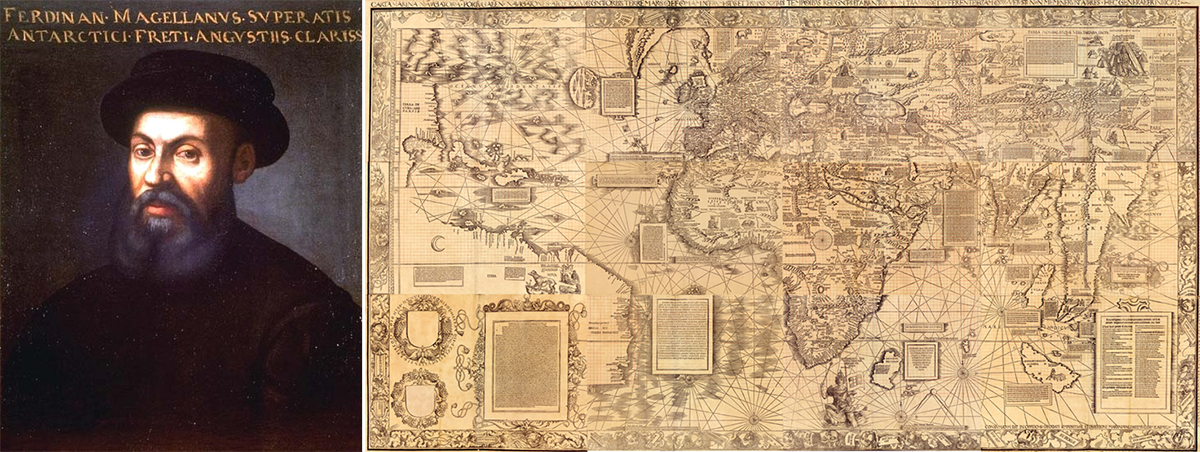
A posthumous portrait of Ferdinand Magellan, painted c. 16th or 17th century (left) ; a 1516 map of the known world at the time of Magellan's voyage (right).
Unable to convince the Portuguese of the importance of finding a route to the west, Magellan then turned to the new king of Spain, Charles I. If Magellan’s expedition was successful, Spain would have access to the goods of the East again.
Like most Spanish-funded endeavors, the people who sailed on this voyage were a diverse group, including German, Greek, French, and Afro-descended crewmembers. Besides Magellan’s Portuguese close friends and family, Spaniards and other Europeans with sailing experiences were brought in, some of them to work off debts. Magellan’s second-in-command was the Spanish overseer and accountant, Juan de Cartagena, and the chronicler was the Venetian Antonio Pigafetta.
Magellan and João Serrão were the only Portuguese captains, with Magellan in charge of the largest ship, the Trinidad , and Serrão at the helm of the Santiago . Spaniards captained the other three ships ( San Antonio , Concepción , and Victoria ), and constant Spanish scheming against the Portuguese would have grave consequences for the voyage.
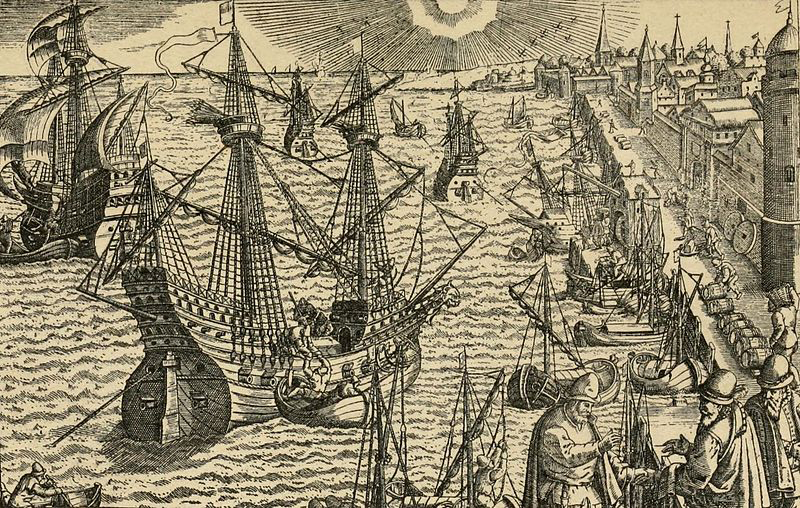
A 19th-century illustration of Magellan's armada preparing to set sail in 1519.
Magellan did nothing to promote Spanish trust, keeping the route a tight secret until the ships were at sea. His plan relied on Portuguese sailing routes, which were well known to him but unfamiliar to many of his crew.
As the armada crossed the Atlantic, morale declined precipitously. By the time the ships arrived on the coast of what is now Brazil to wait out the Southern Hemisphere winter, many aboard were suffering from scurvy, and the Spanish captains were in open rebellion against Magellan. Mutiny was in the air, with Juan de Cartagena, who resented Magellan’s secrecy, leading the effort.
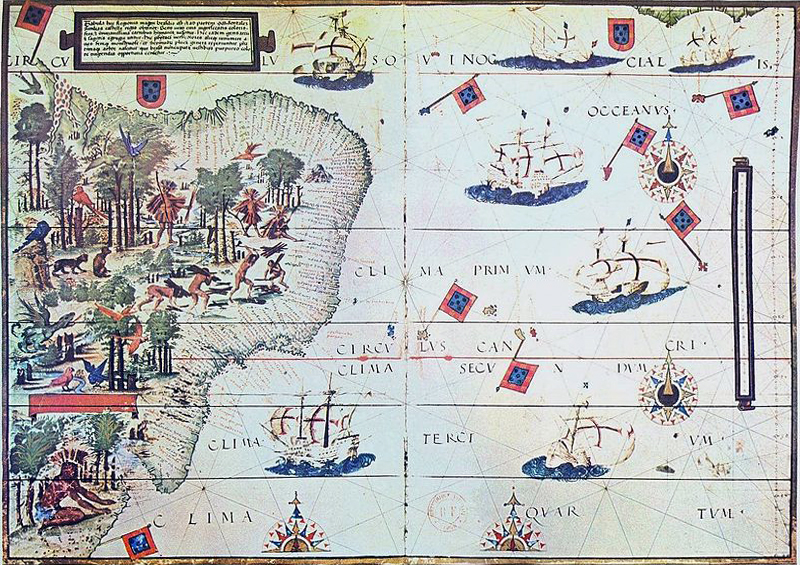
Brazil, as depicted in a 1519 atlas.
In the cold of their wintering grounds and with reduced rations, the mutineers made their move. Although they managed to take over as many as three of the five ships, they were eventually captured and Magellan exiled Cartagena to an uninhabited island off the coast.
The winter of 1520 also saw the destruction of the Santiago, which ran aground while on a scouting mission to the south. Although the ship’s crew survived, the loss of the Santiago put more pressure on an already pinched crew.
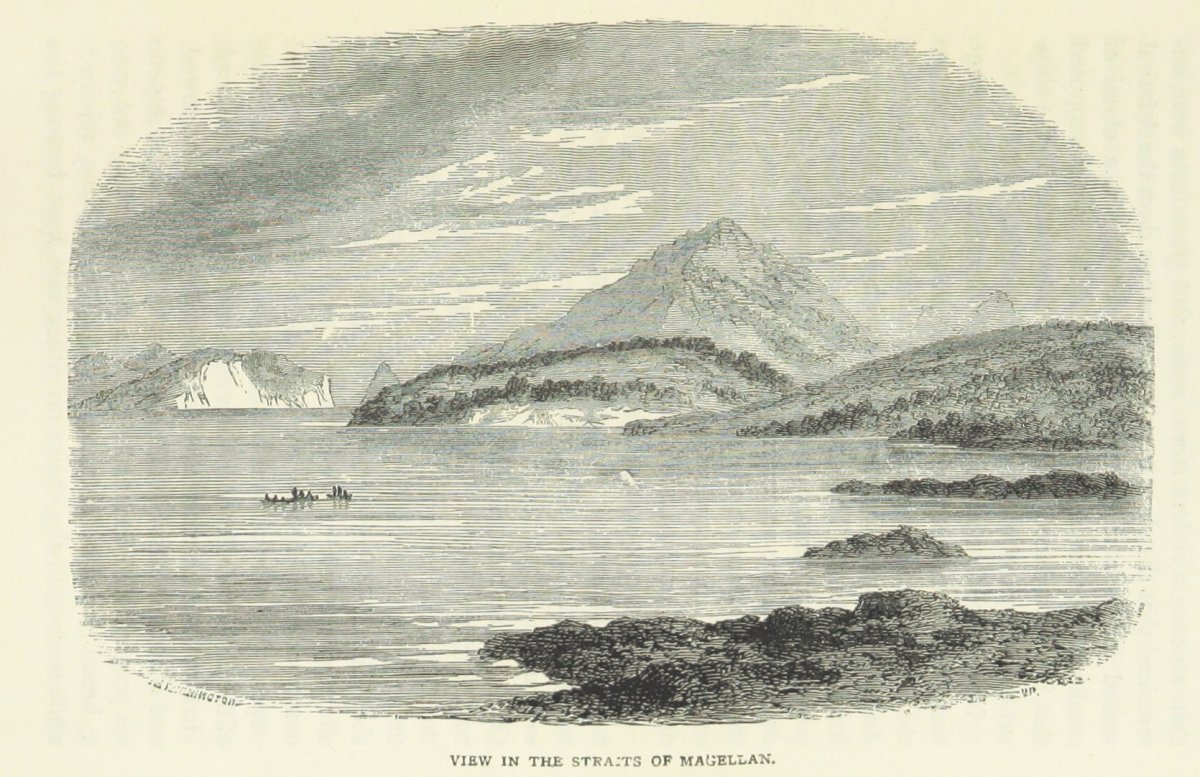
An 1885 drawing of the Strait of Magellan.
By late spring, surviving on seal and penguin meat, the armada entered what is now known as the Strait of Magellan, the narrow body of water separating mainland South America from the Tierra del Fuego. The armada lost another ship during the passage through the Strait: the San Antonio , which became separated from the rest of the armada, and turned around and returned to Spain.
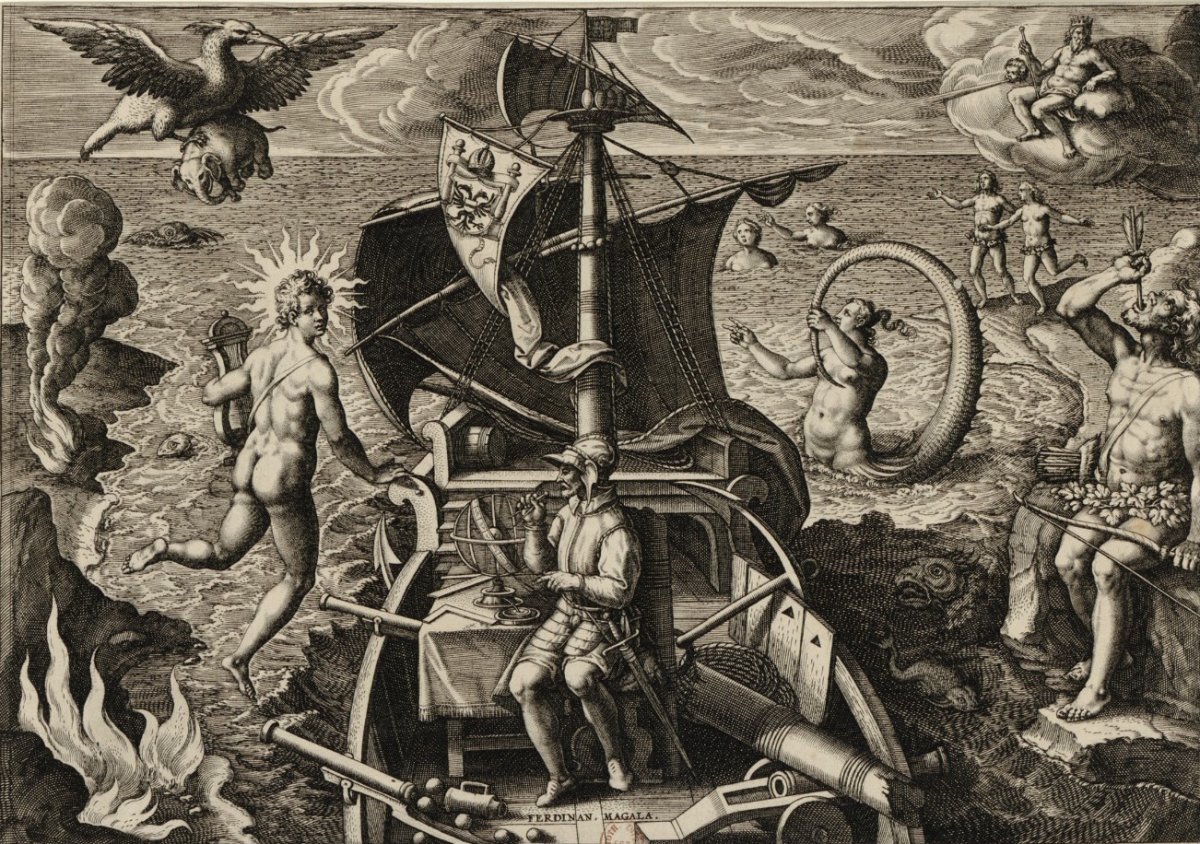
An engraving (c. 1580–1618) of Magellan crossing the Strait that would bear his name.
Once the three remaining ships reached the other side of the Strait of Magellan, the sea they found was calm and placid. Magellan christened it the Pacific Ocean. Crossing the Pacific, the crew of the remaining ships suffered terribly. Twenty-nine sailors died during the four-month voyage.
In April 1521, the group put into an island in the Pacific: Cebu, in what is now the Philippines . As the first Europeans to see these islands, Magellan’s crew would lay the groundwork for the long Spanish colonization of the archipelago, which lasted until 1898. Magellan befriended the local ruler, Raja Humabon, and became embroiled in local politics, which would be his downfall.
On April 27, 1521, Magellan went to war against the ruler Lapu Lapu on Mactan Island, who refused to bring tribute for Raja Humabon and the King of Spain. Fighting in the shallow waters off the shore, Magellan and 49 of his men squared off against over 1,000 Mactanese warriors. Facing such poor odds, Magellan was killed, as well as seven of his men, and his ships returned to Cebu.
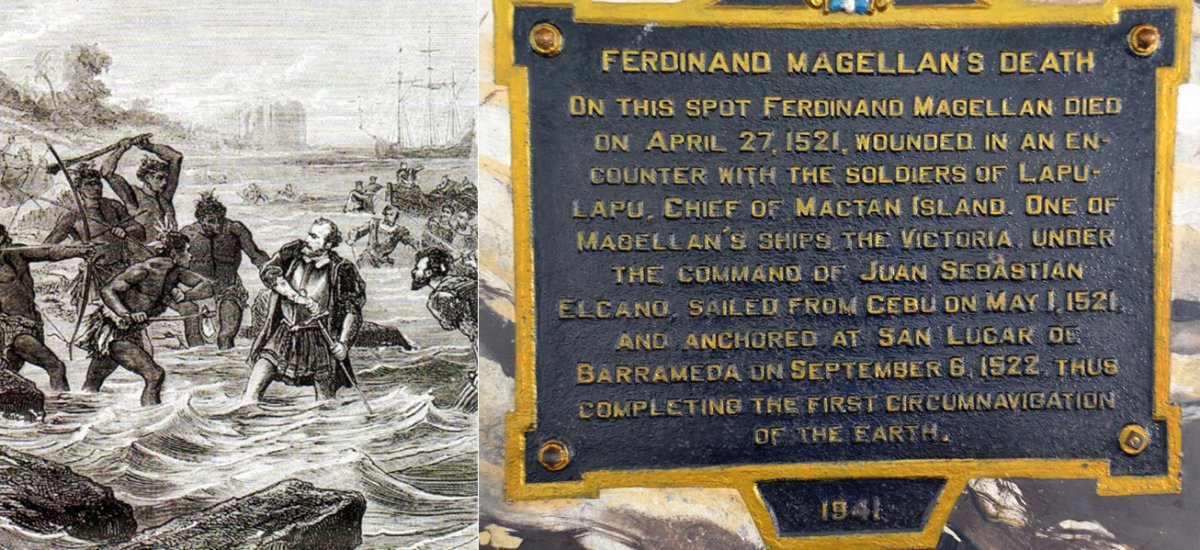
A 19th-century illustration of the death of Magellan (left) ; a plaque in Cebu commemorating the site of Magellan's death, Philippines (right).
Raja Humabon, displeased at the newcomer’s loss, hosted a feast where he poisoned a group of some of the highest-ranking members of the expedition, leaving less than half of the original crew. The rest of the members set sail, fleeing to the safety of the sea. On May 2, 1521, those sailors who remained scuttled the Concepción and divided the crew among the remaining two ships, the Trinidad and the Victoria.
For the next six months the ships engaged in piracy as they made their way to the Spice Islands. Finally, in November, they arrived at the island of Tidore, part of the Malukus, and filled their holds with cloves. The Trinidad, which was taking on water, could not be repaired, and it was abandoned along with its crew.
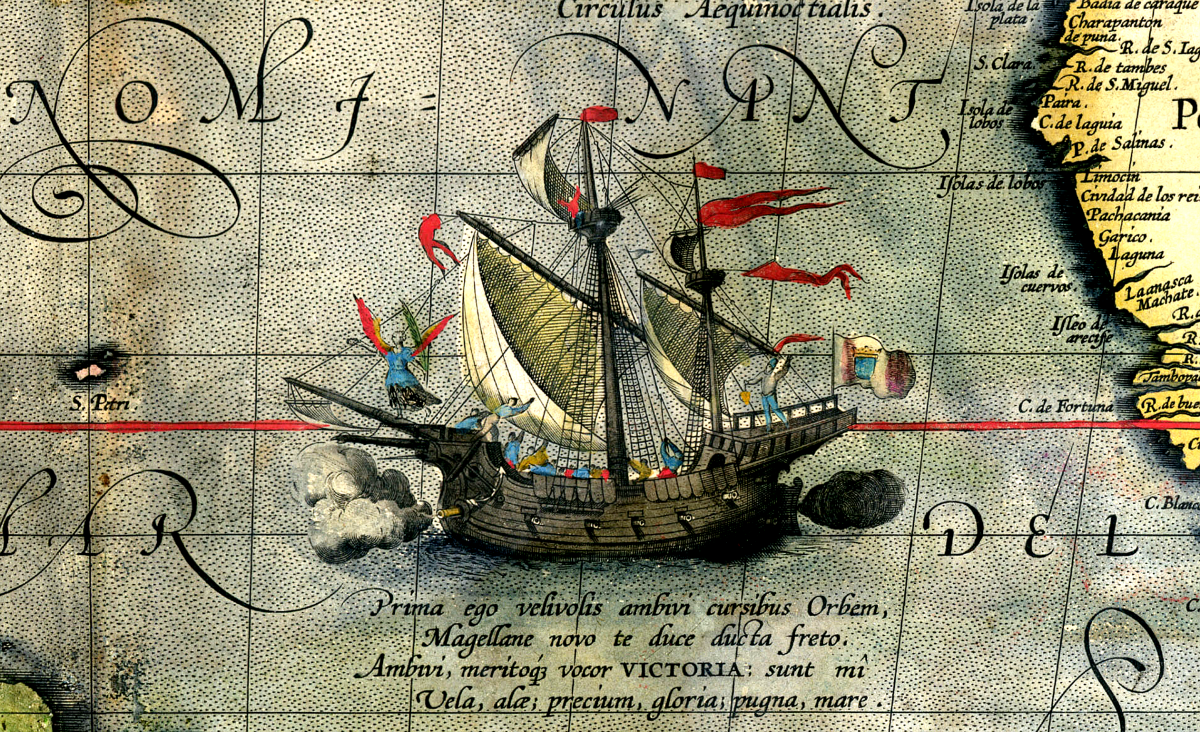
Detail of a 1590 map showing the Victoria , the only ship from the armada to successfully circumnavigate the earth.
The Spaniard Juan Sebastián Elcano was elected captain of the remaining ship Victoria, which set sail west to the Cape of Good Hope at the southern tip of Africa. This voyage took over six months, during which the crew subsisted on rice alone.
On September 6, 1522, the Victoria at last reached harbor in Spain, nearly three years after first setting out. Of the original 270-strong crew, only eighteen had survived.
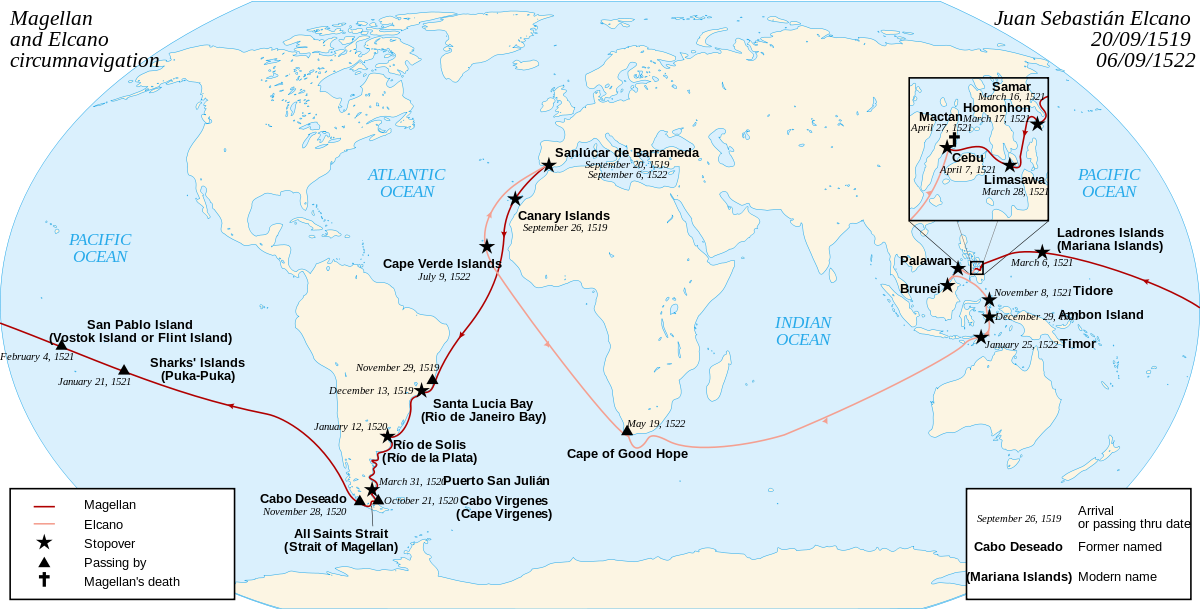
Map showing the route and chronology of the circumnavigation voyage from 1519 to 1522.
Although Magellan is remembered today for circumnavigating the globe, his reputation in the expedition’s immediate aftermath took a battering from those who had survived the expedition. Both the sailors of the Victoria , as well as the crew of the San Antonio who had turned back from the Strait of Magellan in 1520, disparaged him.
Juan Elcano, on the other hand, was given a hero’s welcome, even though he had joined the voyage only to receive a royal pardon. He was elevated to the peerage and added a globe and the words “first to circumnavigate me” to his coat of arms. In Spain, the circumnavigation is known as the Magellan-Elcano expedition.
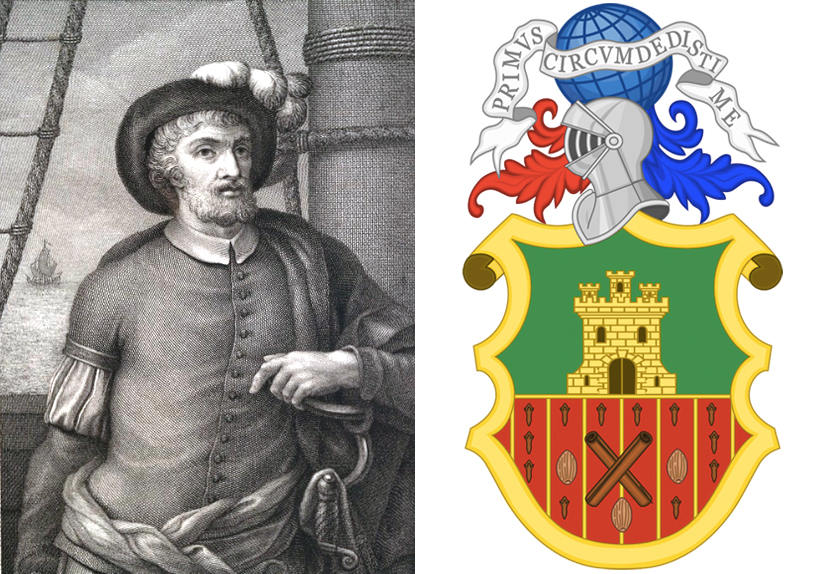
Engraving of Juan Elcano, 1791 (left) ; Juan Elcano's coat of arms, bearing the phrase, "Primus circumdedisti me" ("First to circumnavigate me") (right).
The first recorded circumnavigation had important political, economic, and scientific consequences.
Spain calculated the total circumference of the globe for the first time, and determined that the Pacific was much wider than previously guessed, meaning that they owned some of the Pacific islands as demarcated by the Treaty of Tordesillas. Spain took control of the Philippines, and began exploration of the East Pacific.
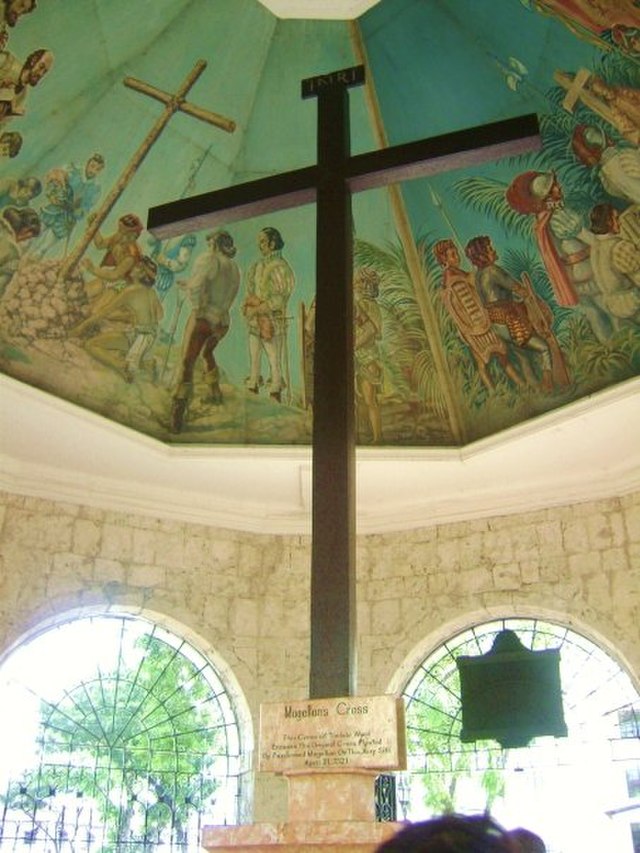
Cross erected by Magellan's crew on the island of Cebu.
Magellan’s voyage also opened the door for trade. By the 1600s, Spanish territories produced most of the world’s silver, and around a third of it ended up in China through trade. This would have lasting effects on global strategy and economies, and propel Spain to the height of European power.
Perhaps just as important for us today, however, is the establishment of the International Date Line. Upon return to Spain, the sailors of the Victoria learned that they were a day behind in their reckoning. As they sailed against the Earth’s rotation, they lost hours. Many mysteries of the globe were revealed.
Premium Content

- HISTORY MAGAZINE
240 men started Magellan's voyage around the world. Only 18 finished it.
The explorer died on a Philippines beach in April 1521, joining the scores who perished in Spain's quest to circumnavigate the globe.
As it moored under Seville’s imposing skyline on September 8, 1522, the Victoria may not have stood out as anything exceptional among the bustle of Spanish ships arriving from the Americas. When 18 men stepped off board, “leaner than old, worn-out nags,” as one of them later recalled, they stepped into the history books as the first people to have sailed entirely around the world.
It had been a brutal voyage, led by the brilliant, if ruthless, Portuguese navigator Ferdinand Magellan. When they set out from Seville, three years before in summer 1519, they were a crew of 240 manning five ships. A series of blows—including starvation, illness, mutiny, executions, and the death of their leader—decimated their numbers and their fleet before returning to Spain.
These men had, however, completed their global journey, despite the violence and greed that marred it from the outset. The venture would be remembered for the skill and endurance of many of its members. As the first Europeans to enter the eastern Pacific, the expedition radically altered Europe’s understanding of the world, while posterity would lionize Magellan for an accomplishment that he never lived to see.
Despite the aura of heroism that has formed around Magellan, his voyage was not driven by geographic curiosity, but by trade and Spain’s struggle to surpass Portugal. Following Christopher Columbus’s voyages of the 1490s and the discovery of a landmass to the west, the two premier naval powers competed to control the new vistas opening before them. In 1493 Pope Alexander VI drew a line from north to south down the Atlantic, decreeing that Spain could exploit the new continent to the west. The papal bull did not specify, however, that Portugal could exploit the territory to the east of the line.
Portugal cried foul, pointing out that the pope, a Borgia of Spanish descent, was not an impartial arbiter. To avoid a war, direct talks opened between Portugal and Spain and the line was moved farther west in the 1494 Treaty of Tordesillas. This allowed Portugal more room to maneuver down the eastern coastline of Africa. Happily for the Portuguese, Pedro Álvares Cabral’s 1500 discovery of the eastern coastline of South America fell on Portugal’s side of the 1494 line.
Portugal had already bested Spain in the exploration race, when in 1497 Vasco de Gama was the first European to discover a sea route to India around Africa. While this period of global exploration is often associated with the Americas, both powers were also seeking riches in the Asia-Pacific. It was there that Magellan gained experience vital to his later expedition. ( Was Magellan the first to sail around the world? Think again. )
For Hungry Minds
A sea change.
Born Fernão de Magalhães in northern Portugal in 1480, Magellan grew up in a noble family. At age 10 he was sent to Lisbon to train as a page in the court of Queen Leonora. He came of age as Europe began shaking off its medieval sensibilities and looking outward. The few sources on his early life suggest he became fascinated with maps and charts, an interest that may have coincided with the news, at age 13, of the Spanish expedition under Columbus that had made landfall in the Americas.
Portuguese eastward expansion began to move rapidly after Vasco de Gama rounded the Cape of Good Hope in 1497. By 1505 the 25-year-old Magellan was with the Portuguese fleet heading around the Cape, and up the other side, to East Africa. The aim of King Manuel of Portugal was to wrest control of the entire Indian Ocean from the Arabs so as to control trade with India.
In 1507 Magellan participated in a naval battle that consolidated Portuguese power over the Indian Ocean. More Portuguese victories followed in Goa (western India), and in 1511 the Portuguese seized Malacca on the Malay Peninsula. The city overlooks the strait through which the spices from modern-day Indonesia were funneled westward. By controlling Malacca, Portugal could exert control over the spice trade.
An older relative (and possible cousin) of Magellan, Francisco Serrão, had also forged a dramatic career as a sailor and took part in the seizure of Malacca before going on an expedition to the Moluccas, or Spice Islands, in 1512. His venture would later inspire Magellan’s own goal to reach them by sailing west from Europe.
Magellan took part in the battle for Malacca and honed his navigational skills during Portugal’s eastern victories. After returning to Europe, in 1514 he entered into a bitter dispute with King Manuel over the king’s refusal to reward him. Having used up all his appeals, Magellan rejected his native land and traveled to the Spanish court at Valladolid in 1517 to offer his services to the Spanish king Charles I (who would become Holy Roman Emperor Charles V in June 1519). From that day, Fernão de Magalhães would be known by his Spanish name, Fernando de Magallanes.
By offering his services to Spain, Magellan was not engaging in any truly scandalous behavior. Seafaring expertise often crossed borders, and crews were drawn from different nations. Columbus too, a Genoan from northern Italy, had offered himself to the Spanish crown after initially working for the Portuguese. Magellan’s plan was strikingly similar to Columbus’s from nearly 30 years earlier: to sail west to bring back spices from the Moluccas, the Spice Islands of Indonesia. ( Discover the secrets hidden in a 500-year-old map used by Columbus. )
Citing the theories of other navigators at the time, Magellan postulated that a strait cut through the Americas to a sea whose eastern shore was first glimpsed by Spanish explorer Vasco Núñez de Balboa in 1513. If he could find it, this passage would allow Spain a kind of “back-door” access to the Moluccas, bypassing Portugal’s Cape route. Magellan’s reputation as a sailor and his knowledge of the east convinced Charles, and the expedition received royal assent.
Not all were happy that this Portuguese interloper had gained such favor with the king. The nobility and the Casa de Contratación (the state body that controlled such expeditions) took every opportunity to obstruct Magellan’s preparations. Under two-thirds of the crew were Spaniards; of the foreigners, 24 were Portuguese and 27 were Italian.
Marvels and mutiny
Among the crew was a young Venetian nobleman named Antonio Pigafetta, a student of astronomy and geography. Pigafetta’s lively journal became history’s principal written source for detailed information on the entire voyage.
“On Monday, August 10, St. Lawrence’s day, the fleet, having been supplied with all the things necessary for the sea, made ready to leave the harbor of Seville,” Pigafetta recorded in his log. Five ships in total—the San Antonio, the Concepción, the Victoria, the Santiago , and the flagship, the Trinidad —struck out west from Spain via the Canary Islands. Pigafetta’s observations were not solely nautical. He took a lively interest in geography and zoology and science, noting different kinds of birds and wildlife.
While Pigafetta wrote his log, Magellan was deeply concerned about his authority. He was officially the supreme commander, but prior to departure, pressure from the Spanish authorities had forced him to accept a nobleman, Juan de Cartagena, as the voyage’s second-in-command. This decision led to violent power struggles during the voyage. Early on, Magellan was forced to arrest and demote Cartagena for insubordination. As a royal appointee, he was otherwise untouchable, but his resentful presence would prove nearly catastrophic for Magellan later.
The coast of modern-day Brazil, which Europeans had only been aware of for 20 years, was a source of wonder. But it was its inhabitants that captured Pigafetta’s attention most. He recorded in his journal that some of the people of “Verdin” (as he called it)
live a hundred, or a hundred and twenty, or a hundred and forty years, and more; they go naked, both men and women. Their dwellings are houses that are rather long . . . [and] in each of these houses . . . there dwells a family of a hundred persons, who make a great noise. In this place they have boats, which are made of a tree, all in one piece, which they call “canoo.” These are not made with iron instruments, for they have not got any . . . Into these thirty or forty men enter.
Pigafetta’s writings revealed a condescending attitude toward the indigenous peoples. His descriptions of the peoples he meets in Patagonia, the Pacific Islands, and lands in Asia are centered on the amount of clothing worn, physical traits including skin color, height, and build, and whether they could be converted to Christianity. He recorded certain words from their languages, many of which related to commodities that could be of use to colonial Spain. ( See a shipwreck from explorer Vasco da Gama's fleet. )
The small armada sailed south, scanning for any strait or opening in the great landmass to starboard. A great inlet in early 1520 aroused much excitement. Once it had been ascertained it was not the longed-for strait, but a river mouth (the Río de la Plata), the fleet continued south to San Julián, where, in April, surrounded on all sides by the frozen expanse of Patagonia, a full-scale mutiny was launched against Magellan by the captains of the four other ships.
Played out across five vessels, the scenes were chaotic and confusing, but Magellan prevailed. In the ensuing skirmishes, the rebellious captains of the Victoria and the Concepción were arrested and executed. One of the leaders of the revolt was the demoted and resentful Juan de Cartagena. Magellan opted to maroon him on an island, thus avoiding shedding the blood of a powerful nobleman, while also ridding himself of an incompetent troublemaker. Cartagena’s fate is unknown, but other mutineers were pardoned, including one of the officers, Juan Sebastián Elcano.
You May Also Like

Magellan got the credit, but this man was first to sail around the world

Has Amelia Earhart’s plane really been found? 6 key things to know


This legendary Polynesian canoe will sail 43,000 miles, from Alaska to Tahiti
Shortly after the failed mutiny, as resentments still simmered, Magellan lost the Santiago in a storm. Unbowed, the reduced fleet continued south until glacial conditions forced a halt for two months to provision; then it set out once more. Finally, as Pigafetta records on “the day of the feast of the eleven thousand virgins,” St. Ursula’s Day which falls on October 21, they sighted a strait “surrounded by lofty mountains laden with snow... Had it not been for the captain-general, we would not have found that strait, for we all thought that it was closed on all sides.”
For over a month, buffeted by storms and currents, the fleet ventured down the strait that Charles V would later name for Magellan. The commander named an archipelago they saw on the south side Tierra del Fuego (“land of fire”) in reference to the many bonfires lit there by its indigenous hunter-gatherer peoples, who had occupied this tip of South America for millennia.
In the course of this passage, another ship disappeared: the San Antonio . Pigafetta records it had been believed lost; in fact, it had deserted and was returning to Spain. Equipped now with only three vessels, Magellan and his men “on Wednesday, November 28, 1520, . . . debouched from that strait, engulfing . . . in the Pacific Sea.” They were the first Europeans to enter that vast ocean from its eastern shore.
Hard crossing
After being borne northward along what is today the Chilean coast, Magellan’s fleet finally struck out northwest in search of land beyond. Magellan knew that the Malay archipelago he had visited years before must lie somewhere to the west. To find it, the limping expedition had to sail through rough seas for over three months.
Hunger and disease stalked the crossing. Pigafetta records how he and his crewmates ate sawdust, ox hides, and “biscuit, which was no longer biscuit, but powder of biscuits swarming with worms, and which stank strongly of the urine of rats.” General privation, the lack of food, and illness greatly reduced their numbers. Perhaps the most devastating was scurvy, the distinctive symptoms of which Pigafetta captured: “[I]t was that the upper and lower gums of most of our men grew so much that they could not eat, and in this way so many suffered, that nineteen died.” ( Scurvy killed more people than the American Civil War. )
Savaged by scurvy
While crossing the Pacific, Pigafetta recorded how many of Magellan’s crew seemed to waste away from a horrific illness: Their gums bled, their limbs ulcerated, and delirium addled their minds. Scurvy and its symptoms, which are caused by a lack of vitamin C, would ravage many European expeditions. The captain who completed the Magellan expedition, Juan Sebastián Elcano, succumbed to scurvy on a later voyage, and it killed an estimated two million sailors between the 15th and 18th centuries. The medical properties of vitamin C were not discovered until the 1920s, but it became common wisdom in the 1700s that citrus fruit could be a preventative, a remedy that was resisted by some in the British Navy. It was not until the 1790s that fruit was distributed routinely among crews.
On March 6, 1521, after 100 days in Pacific waters, the exhausted armada finally was able to make landfall in the Mariana Islands where they restocked the ships and then continued west. Days later, they reached an archipelago (later christened the Philippines by another Spanish explorer) of many inhabited islands that Magellan would attempt to claim for Spain. The crew celebrated mass on the island of Limasawa in late March and then converted the rulers of Cebu Island to Christianity.
Magellan heard that rivals of the Becu who lived on the nearby island of Mactan refused to convert and submit to Spain. Magellan tried to claim their land for Spain and their souls for the church, but the occupants of Mactan Island, led by the chieftain known traditionally as Lapulapu, stood firm in the face of Spanish guns and swords. On April 27, 1521, Magellan led 60 men to the island with an ultimatum to surrender. The islanders refused, and a fierce battle ensued, which Pigafetta recounted:
When we reached land we found the islanders fifteen hundred in number . . . they came down upon us with terrible shouts . . . seeing that the shots of our guns did them little or no harm [they] would not retire, but shouted more loudly, and . . . at the same time drew nearer to us, throwing arrows, javelins, spears hardened in fire, stones, and even mud, so that we could hardly defend ourselves.
Pigafetta reported that Magellan was killed by Lapulapu and his warriors on the shore. Despite Spanish firepower, the islanders quickly overcame the invaders with their numbers and bravery and drove them back. The Europeans retreated, leaving their commander to die on the beach; Magellan’s body was never recovered. Later, the king of Cebu would turn against the Europeans, too, and kill 26 of them. The remaining Europeans soon departed.
Their numbers dwindling, the surviving crew, under the command of Juan Sebastián Elcano, did finally reach the Moluccas in November 1521. They were able to stock up the ships with spices and goods to bring back to Spain. Having been forced to abandon two of their three remaining ships, the crew would return to Spain in a fleet of one—the Victoria . Ten months later, the ship and its bedraggled crew of 18, including Pigafetta, entered Seville’s harbor. ( Who really discovered Antarctica? )
Final frontier
The first continuous circumnavigation of the world was complete. It took almost exactly three years and, surprisingly, turned a profit. The 381 sacks of cloves brought back by the Victoria were worth more than all five ships that had set out on the voyage. Despite the hopes and funds invested, it did not translate into immediate meaningful economic benefits for Spain. The treacherous course around the tip of South America was never a practical route for trade with the Moluccas.
Despite the death and destruction brought on by the voyage, many historians believe Magellan’s expedition was a worthy accomplishment. The careful records kept by Pigafetta and others dramatically expanded Europe’s knowledge of the world beyond the Atlantic, giving cartographers a firm sense of the world’s actual size and future navigators intelligence on the conditions and currents of the Pacific Ocean. Europeans had known of the eastern shore of the Pacific since 1513, but Magellan revealed its sheer size and power, knowledge that transformed Europeans’ understanding of the extent of the globe.
Related Topics
- CIRCUMNAVIGATION
- IMPERIALISM
- AGE OF DISCOVERY

Meet the ruthless king who unified the Kingdom of Hawai'i

Who gets to claim the ‘world’s richest shipwreck’?

Mass grave found in Fiji sparks a mystery: cannibalism or contagion?

Queen Elizabeth I's favorite pirate was an English hero, but his career has a dark side

See scenes from classic fairy tales—with a Nigerian twist
- Environment
History & Culture
- History & Culture
- History Magazine
- Gory Details
- Mind, Body, Wonder
- Paid Content
- Terms of Use
- Privacy Policy
- Your US State Privacy Rights
- Children's Online Privacy Policy
- Interest-Based Ads
- About Nielsen Measurement
- Do Not Sell or Share My Personal Information
- Nat Geo Home
- Attend a Live Event
- Book a Trip
- Inspire Your Kids
- Shop Nat Geo
- Visit the D.C. Museum
- Learn About Our Impact
- Support Our Mission
- Advertise With Us
- Customer Service
- Renew Subscription
- Manage Your Subscription
- Work at Nat Geo
- Sign Up for Our Newsletters
- Contribute to Protect the Planet
Copyright © 1996-2015 National Geographic Society Copyright © 2015-2024 National Geographic Partners, LLC. All rights reserved
- History Classics
- Your Profile
- Find History on Facebook (Opens in a new window)
- Find History on Twitter (Opens in a new window)
- Find History on YouTube (Opens in a new window)
- Find History on Instagram (Opens in a new window)
- Find History on TikTok (Opens in a new window)
- This Day In History
- History Podcasts
- History Vault
This Day In History : September 6
Changing the day will navigate the page to that given day in history. You can navigate days by using left and right arrows
Magellan’s expedition circumnavigates globe

One of Ferdinand Magellan ’s five ships—the Victoria— arrives at Sanlúcar de Barrameda in Spain, thus completing the first circumnavigation of the world. The Victoria was commanded by Basque navigator Juan Sebastian de Elcano, who took charge of the vessel after Magellan was killed in the Philippines in April 1521. During a long, hard journey home, the people on the ship suffered from starvation, scurvy, and harassment by Portuguese ships. Only Elcano and 21 other passengers survived to reach Spain in September 1522.
On September 20, 1519, Magellan set sail from Spain in an effort to find a western sea route to the rich Spice Islands of Indonesia. In command of five ships and 270 men, Magellan sailed to West Africa and then to Brazil, where he searched the South American coast for a strait that would take him to the Pacific. He searched the Rio de la Plata, a large estuary south of Brazil, for a way through; failing, he continued south along the coast of Patagonia. At the end of March 1520, the expedition set up winter quarters at Port St. Julian. On Easter day at midnight, the Spanish captains mutinied against their Portuguese captain, but Magellan crushed the revolt, executing one of the captains and leaving another ashore when his ship left St. Julian in August.
On October 21, he finally discovered the strait he had been seeking. The Strait of Magellan, as it became known, is located near the tip of South America, separating Tierra del Fuego and the continental mainland. Only three ships entered the passage; one had been wrecked and another deserted. It took 38 days to navigate the treacherous strait, and when ocean was sighted at the other end Magellan wept with joy. He was the first European explorer to reach the Pacific Ocean from the Atlantic. His fleet accomplished the westward crossing of the ocean in 99 days, crossing waters so strangely calm that the ocean was named “Pacific,” from the Latin word pacificus, meaning “tranquil.” By the end, the men were out of food and chewed the leather parts of their gear to keep themselves alive. On March 6, 1521, the expedition landed at the island of Guam.
Ten days later, they dropped anchor at the Philippine island of Cebu–they were only about 400 miles from the Spice Islands. Magellan met with the chief of Cebú, who after converting to Christianity persuaded the Europeans to assist him in conquering a rival tribe on the neighboring island of Mactan. In subsequent fighting on April 27, Magellan was hit by a poisoned arrow and left to die by his retreating comrades.
After Magellan’s death, the survivors, in two ships, sailed on to the Moluccas and loaded the hulls with spice. One ship attempted, unsuccessfully, to return across the Pacific. The other ship, the Victoria, continued west under the command of Juan Sebastian de Elcano. The vessel sailed across the Indian Ocean, rounded the Cape of Good Hope, and arrived at the Spanish port of Sanlúcar de Barrameda on September 6, 1522, becoming the first ship to circumnavigate the globe. The Victoria then sailed up the Guadalquivir River, reaching Seville a few days later.
Elcano was later appointed to lead a fleet of seven ships on another voyage to Moluccas on behalf of Emperor Charles V. He died of scurvy en route.
Also on This Day in History September | 6
Teen tennis star navratilova seeks political asylum in u.s., off-duty police officer mistakenly enters neighbor's apartment and shoots its owner to death.
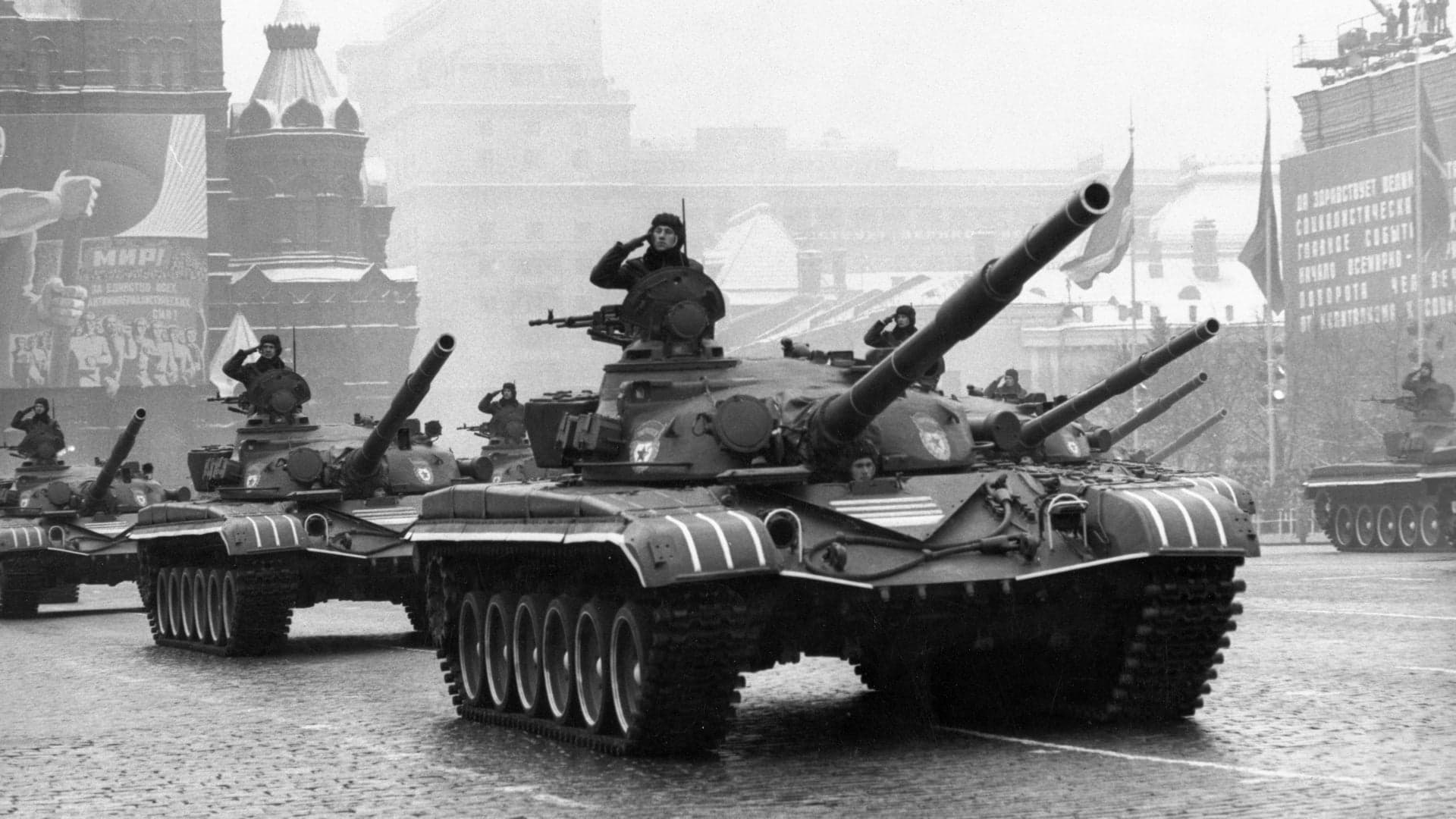
This Day in History Video: What Happened on September 6
More israeli hostages killed in munich, south african prime minister and architect of apartheid assassinated.
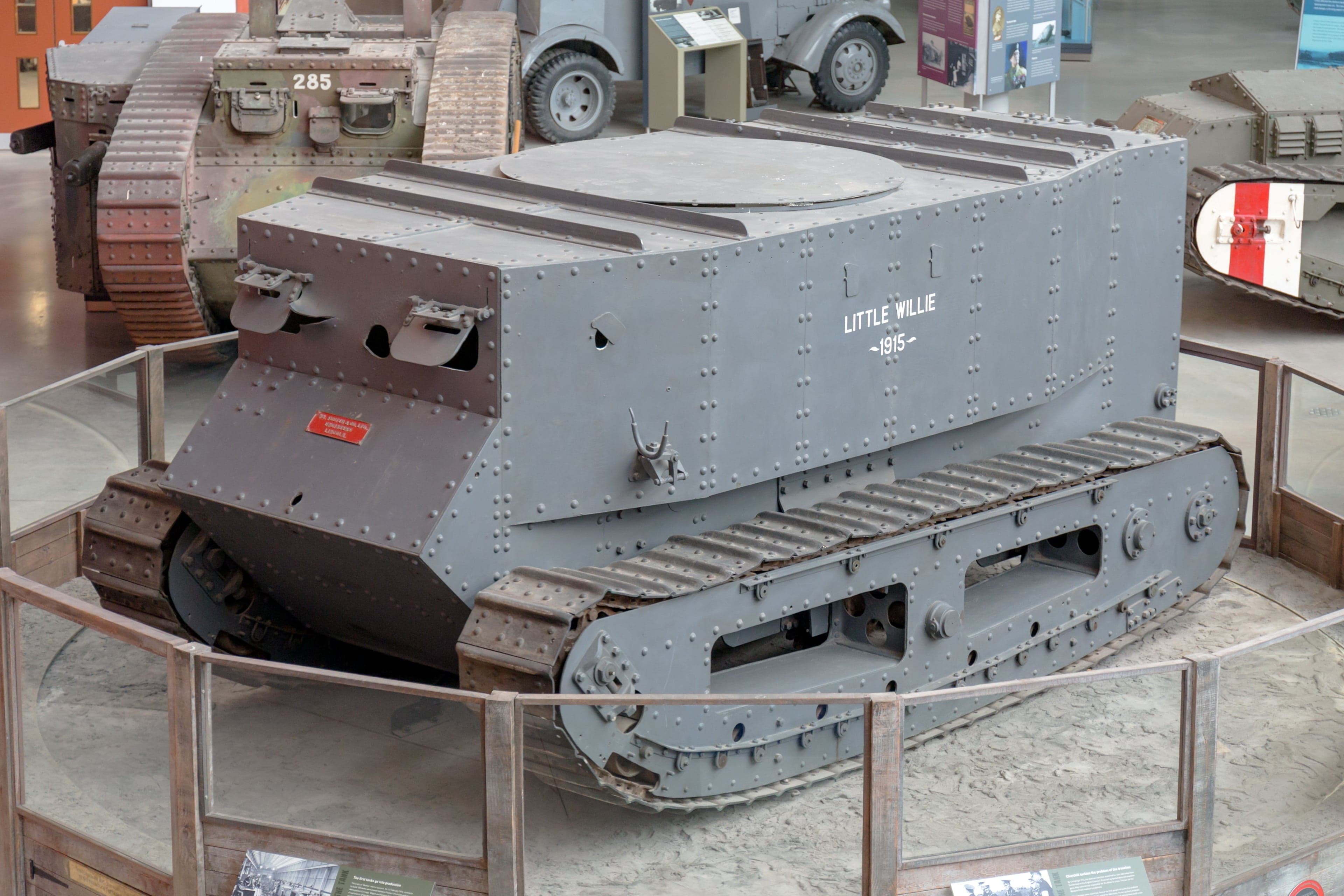
First tank produced

Wake Up to This Day in History
Sign up now to learn about This Day in History straight from your inbox. Get all of today's events in just one email featuring a range of topics.
By submitting your information, you agree to receive emails from HISTORY and A+E Networks. You can opt out at any time. You must be 16 years or older and a resident of the United States.
More details : Privacy Notice | Terms of Use | Contact Us
First Battle of the Marne begins
Baltimore orioles shortstop cal ripken jr. breaks record for consecutive games played, president william mckinley is shot, henry david thoreau leaves walden and moves in with the emersons, some 2.5 billion tv viewers watch princess diana’s funeral, benedict arnold orders burning of new london.
Voyages of Ferdinand Magellan Timeline
First voyage, king charles i finances the voyage, rio de janeiro, strait of magellan, philippines, death in battle, rounding the cape, voyage home.

Voyages of Ferdinand Magellan
The Magellan expedition, also known as the Magellan–Elcano expedition, was the first voyage around the world. It was a 16th century Spanish expedition initially led by Portuguese explorer Ferdinand Magellan to the Moluccas, which departed from Spain in 1519, and completed in 1522 by Spanish navigator Juan Sebastián Elcano, after crossing the Atlantic, Pacific and Indian oceans, culminating in the first circumnavigation of the world.
The expedition accomplished its primary goal – to find a western route to the Moluccas (Spice Islands). The fleet left Spain on 20 September 1519, sailed across the Atlantic ocean and down the eastern coast of South America, eventually discovering the Strait of Magellan, allowing them to pass through to the Pacific Ocean (which Magellan named). The fleet completed the first Pacific crossing, stopping in the Philippines , and eventually reached the Moluccas after two years. A much-depleted crew led by Juan Sebastián Elcano finally returned to Spain on 6 September 1522, having sailed west across the great Indian Ocean, then around the Cape of Good Hope through waters controlled by the Portuguese and north along the Western African coast to eventually arrive in Spain.
The fleet initially consisted of five ships and about 270 men. The expedition faced numerous hardships including Portuguese sabotage attempts, mutinies, starvation, scurvy, storms, and hostile encounters with indigenous people. Only 30 men and one ship (the Victoria) completed the return trip to Spain. Magellan himself died in battle in the Philippines, and was succeeded as captain-general by a series of officers, with Elcano eventually leading the Victoria's return trip.
The expedition was funded mostly by King Charles I of Spain, with the hope that it would discover a profitable western route to the Moluccas, as the eastern route was controlled by Portugal under the Treaty of Tordesillas. Though the expedition did find a route, it was much longer and more arduous than expected, and was therefore not commercially useful. Nevertheless, the expedition is regarded as one of the greatest achievements in seamanship, and had a significant impact on the European understanding of the world.

In March 1505 at the age of 25, Magellan enlisted in the fleet of 22 ships sent to host Francisco de Almeida as the first viceroy of Portuguese India . Although his name does not appear in the chronicles, it is known that he remained there eight years, in Goa, Cochin and Quilon. He participated in several battles, including the battle of Cannanore in 1506, where he was wounded. In 1509 he fought in the battle of Diu.

After having his proposed expeditions to the Spice Islands repeatedly rejected by King Manuel of Portugal, Magellan turned to Charles I, the young King of Spain (and future Holy Roman Emperor). Under the 1494 Treaty of Tordesillas, Portugal controlled the eastern routes to Asia that went around Africa. Magellan instead proposed reaching the Spice Islands by a western route, a feat which had never been accomplished. Hoping that this would yield a commercially useful trade route for Spain , Charles approved the expedition, and provided most of the funding.

On 10 August 1519, the five ships under Magellan's command left Seville and descended the Guadalquivir River to Sanlúcar de Barrameda, at the mouth of the river. There they remained more than five weeks. The fleet left Spain on 20 September 1519, sailing west across the Atlantic toward South America. Magellan's fleet consisted of five ships, carrying supplies for two years of travel. The crew consisted of about 270 men. Most were Spanish, but around 40 were Portuguese.

On 13 December, the fleet reached Rio de Janeiro, Brazil . Though nominally Portuguese territory, they maintained no permanent settlement there at the time. Seeing no Portuguese ships in the harbour, Magellan knew it would be safe to stop.
The fleet spent 13 days in Rio, during which they repaired their ships, stocked up on water and food (such as yam, cassava, and pineapple), and interacted with the locals. The expedition had brought with them a great quantity of trinkets intended for trade, such as mirrors, combs, knives and bells. The locals readily exchanged food and local goods (such as parrot feathers) for such items. The crew also found they could purchase sexual favours from the local women. Historian Ian Cameron described the crew's time in Rio as "a saturnalia of feasting and lovemaking".
On 27 December, the fleet left Rio de Janeiro. Pigafetta wrote that the natives were disappointed to see them leave, and that some followed them in canoes trying to entice them to stay.

After three months of searching (including a false start in the estuary of Río de la Plata), weather conditions forced the fleet to stop their search to wait out the winter. They found a sheltered natural harbor at the port of Saint Julian, and remained there for five months. Shortly after landing at St. Julian, there was a mutiny attempt led by the Spanish captains Juan de Cartagena, Gaspar de Quesada and Luis de Mendoza. Magellan barely managed to quell the mutiny, despite at one point losing control of three of his five ships to the mutineers. Mendoza was killed during the conflict, and Magellan sentenced Quesada and Cartagena to being beheaded and marooned, respectively. Lower-level conspirators were made to do hard labor in chains over the winter, but later freed.

During the winter, one of the fleet's ships, the Santiago, was lost in a storm while surveying nearby waters, though no men were killed. Following the winter, the fleet resumed their search for a passage to the Pacific in October 1520. Three days later, they found a bay which eventually led them to a strait, now known as the Strait of Magellan, which allowed them passage through to the Pacific. While exploring the strait, one of the remaining four ships, the San Antonio, deserted the fleet, returning east to Spain. The fleet reached the Pacific by the end of November 1520. Based on the incomplete understanding of world geography at the time, Magellan expected a short journey to Asia, perhaps taking as little as three or four days. In fact, the Pacific crossing took three months and twenty days. The long journey exhausted their supply of food and water, and around 30 men died, mostly of scurvy. Magellan himself remained healthy, perhaps because of his personal supply of preserved quince.

On 6 March 1521, the exhausted fleet made landfall at the island of Guam and were met by native Chamorro people who came aboard the ships and took items such as rigging, knives, and a ship's boat. The Chamorro people may have thought they were participating in a trade exchange (as they had already given the fleet some supplies), but the crew interpreted their actions as theft. Magellan sent a raiding party ashore to retaliate, killing several Chamorro men, burning their houses, and recovering the 'stolen' goods

On 16 March, the fleet reached the Philippines , where they would remain for a month and a half. Magellan befriended local leaders on the island of Limasawa, and on 31 March, held the first Mass in the Philippines, planting a cross on the island's highest hill. Magellan set about converting the locals to Christianity . Most accepted the new religion readily, but the island of Mactan resisted.

On 27 April, Magellan and members of his crew attempted to subdue the Mactan natives by force, but in the ensuing battle, the Europeans were overpowered and Magellan was killed by Lapulapu, a native chieftain in Mactan.

Following his death, Magellan was initially succeeded by co-commanders Juan Serrano and Duarte Barbosa (with a series of other officers later leading). The fleet left the Philippines (following a bloody betrayal by former ally Rajah Humabon) and eventually made their way to the Moluccas in November 1521. Laden with spices, they attempted to set sail for Spain in December, but found that only one of their remaining two ships, the Victoria, was seaworthy.

The Victoria set sail via the Indian Ocean route home on 21 December 1521, commanded by Juan Sebastián Elcano. By 6 May 1522 the Victoria rounded the Cape of Good Hope, with only rice for rations.

Twenty crewmen died of starvation by 9 July 1522, when Elcano put into Portuguese Cape Verde for provisions. The crew was surprised to learn that the date was actually 10 July 1522, as they had recorded every day of the three-year journey without omission. They had no trouble making purchases at first, using the cover story that they were returning to Spain from the Americas. However, the Portuguese detained 13 crew members after discovering that Victoria was carrying spices from the East Indies. The Victoria managed to escape with its cargo of 26 tons of spices (cloves and cinnamon).

On 6 September 1522, Elcano and the remaining crew of Magellan's voyage arrived in Sanlúcar de Barrameda in Spain aboard Victoria, almost exactly three years after they departed. They then sailed upriver to Seville, and from there overland to Valladolid, where they appeared before the Emperor. When Victoria, the one surviving ship and the smallest carrack in the fleet, returned to the harbour of departure after completing the first circumnavigation of the Earth, only 18 men out of the original 270 men were on board. In addition to the returning Europeans, the Victoria had aboard three Moluccans who came aboard at Tidore.
Magellan has come to be renowned for his navigational skill and tenacity. The first circumnavigation has been called "the greatest sea voyage in the Age of Discovery", and even "the most important maritime voyage ever undertaken". Appreciation of Magellan's accomplishments may have been enhanced over time by the failure of subsequent expeditions which attempted to retrace his route, beginning with the Loaísa expedition in 1525 (which featured Juan Sebastián Elcano as second-in-command). The next expedition to successfully complete a circumnavigation, led by Francis Drake, would not occur until 1580, 58 years after the return of the Victoria.
Magellan named the Pacific Ocean (which was also often called the Sea of Magellan in his honor until the eighteenth century), and lends his name to the Strait of Magellan.
Even though Magellan did not survive the trip, he has received more recognition for the expedition than Elcano has, since Magellan was the one who started it, Portugal wanted to recognize a Portuguese explorer, and Spain feared Basque nationalism.
How Did the Caravel Change the World?

Technology of the Age of Exploration
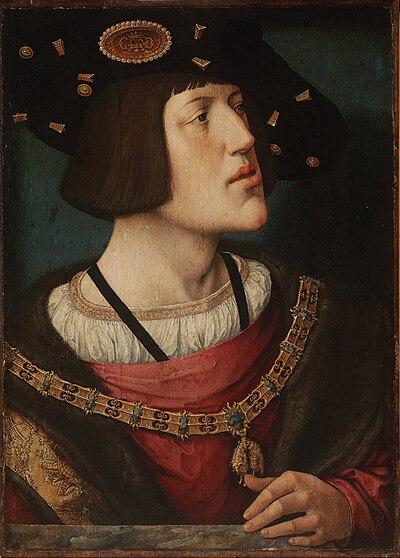
Holy Roman Emperor

Ferdinand Magellan
Portuguese Explorer

Juan Sebastián Elcano
Castilian Explorer

Juan de Cartagena
Spanish Explorer

Francisco de Almeida

Mactan Datu
- The First Voyage Round the World, by Magellan, full text, English translation by Lord Stanley of Alderley, London: Hakluyt, [1874] – six contemporary accounts of his voyage
- Guillemard, Francis Henry Hill (1890), The life of Ferdinand Magellan, and the first circumnavigation of the globe, 1480–1521, G. Philip, retrieved 8 April 2009
- Zweig, Stefan (2007), Conqueror of the Seas – The Story of Magellan, Read Books, ISBN 978-1-4067-6006-4

IMAGES
VIDEO
COMMENTS
Ferdinand Magellan (born 1480, Sabrosa or Porto?, Portugal—died April 27, 1521, Mactan, Philippines) was a Portuguese navigator and explorer who sailed under the flags of both Portugal (1505-13) and Spain (1519-21). From Spain, he sailed around South America, discovering the Strait of Magellan, and across the Pacific.Though he was killed in the Philippines, one of his ships continued ...
The Magellan expedition, also known as the Magellan-Elcano expedition, was a 16th-century Spanish expedition planned and led by Portuguese explorer Ferdinand Magellan.One of the most important voyages in the Age of Discovery—and in the history of exploration—its purpose was to cross the Atlantic and Pacific Oceans to open a trade route with the Moluccas, or Spice Islands, in present-day ...
Ferdinand Magellan (c. 1480 - 27 April 1521) was a Portuguese explorer best known for having planned and led the 1519 Spanish expedition to the East Indies across the Pacific Ocean to open a maritime trade route, during which he discovered the interoceanic passage thereafter bearing his name and achieved the first European navigation to Asia via the Pacific.
In Philippine history classes, students are usually taught about March 1521 as one of the most important events of our shared past. The story of Ferdinand Magellan's "discovery" of the Philippines while in search of another route to nearby Moluccas and his subsequent death at the hands of Lapu-Lapu is treated as a landmark event of Philippine history: the true "beginning" of our ...
928 the present.32 Christianity, which Magellan was the first to introduce to the Philippines, remains the dominant religion with many modern Filipinos proudly proclaiming "that they are the only Christian nation in all of Asia."33 The Santo Niño icon continues to play an important role in the devotional lives of faithful Filipino Catholics.
Magellan's Expedition. Ferdinand Magellan was a Portuguese explorer who was determined to reach India and the East Indies by a new route - under the southern end of America. His journey to the Philippines is believed to have been the first documented European expedition to the archipelago. Born into a family of nobility in Portugal, and despite ...
Half-length portrait of Ferdinand Magellan (circa 1580-1521), first European to circle the globe. The Mariners Museum 1949.0619.000001. Introduction. Ferdinand Magellan is known for circumnavigating - sailing around - the world. From Spain he sailed around South America, discovering the Strait of Magellan, and across the Pacific.
Ferdinand Magellan, or Fernão de Magalhães (c. 1480-1521), was a Portuguese mariner whose expedition was the first to circumnavigate the globe in 1519-22 in the service of Spain.Magellan was killed on the voyage in what is today the Philippines, and only 22 of the original 270 crew members made it back to Europe.. Discovering what became known as the Straits of Magellan in southern Patagonia ...
This Day in World History March 16, 1521 Magellan Reaches the Philippines. On March 16, 1521, Portuguese navigator Ferdinand Magellan, attempting to sail around the world for Spain, reached the Philippine archipelago.Magellan and his expedition were the first Europeans to reach the Philippines, a stop on the first circumnavigation of the globe, though Magellan's portion of that journey would ...
tral to the history of Magellan's voyage to the Philippines, namely: the location and date of the first Mass and Magellan's fate at Mactan Island in April 1521. Magellan's Reasons for Being in the Archipelago of San Lazaro Ferdinand Magellan is widely regarded as having been an out? standing seaman and navigator. Various commentators present ...
In search of fame and fortune, Portuguese explorer Ferdinand Magellan (c. 1480-1521) set out from Spain in 1519 with a fleet of five ships to discover a western sea route to the Spice Islands.
Mar 16, 2021, 10:14 pm. THIS year, the world celebrates the 500th anniversary of the Ferdinand Magellan-Sebastian Elcano expedition and the 500th anniversary of the birth of Christianity in the Philippines. As we celebrate this special anniversary of the first global voyage, let us trace this momentous expedition from Spain to the Philippines ...
On April 27, 1521, Portuguese explorer Ferdinand Magellan was killed by a poison arrow during a skirmish on the island of Mactan in what is now the Philippines. Magellan and his crew were assisting a local king they had allied with when they landed on the island of Cebu weeks earlier. Magellan and his crew endured a long voyage to the Philippines.
Spain took control of the Philippines, and began exploration of the East Pacific. Cross erected by Magellan's crew on the island of Cebu. Magellan's voyage also opened the door for trade. By the 1600s, Spanish territories produced most of the world's silver, and around a third of it ended up in China through trade. This would have lasting ...
Limasawa, Philippines. On 16 March, the fleet reached the Philippines, where they would remain for a month and a half. Magellan befriended local leaders on the island of Limasawa, and on 31 March, held the first Mass in the Philippines, planting a cross on the island's highest hill. Magellan set about converting the locals to Christianity.
Earlier in the month, his ships had dropped anchor at the Philippine island of Cebu, and Magellan met with the local chief, ... Ten years after his 1492 voyage, Columbus, awaiting the gallows on ...
Richard J. Field, 'Revisiting Magellan's Voyage to the Philippines', Philippine Quarterly of Culture and Society, 34, No. 4 (2006), 313-37. Field is one of the few historians who correctly interpret Magellan's intentions. An article by Scott Fitzpatrick and Richard Callaghan laboriously attempts to understand why Magellan did not follow ...
The Magellan expedition (10 August or 20 September 1519 - 6 September 1522) was the first voyage around the world in human history. It was a Spanish expedition that sailed from Seville in 1519 under the initial command of Ferdinand Magellan , a Portuguese sailor, and completed in 1522 by Spanish Basque navigator Juan Sebastián Elcano .
HISTORY MAGAZINE. 240 men started Magellan's voyage around the world. Only 18 finished it. The explorer died on a Philippines beach in April 1521, joining the scores who perished in Spain's quest ...
The Magellan expedition started off through the westward route and returning to Spain by going east; Magellan and Elcano's entire voyage took almost three years to complete. Spain sends other expedition. After the Spain had celebrated Elcano's return, King Charles I decided that Spain should conquer the Philippines. Five subsequent ...
The Victoria was commanded by Basque navigator Juan Sebastian de Elcano, who took charge of the vessel after Magellan was killed in the Philippines in April 1521. During a long, hard journey home ...
The Magellan expedition, also known as the Magellan-Elcano expedition, was the first voyage around the world. It was a 16th century Spanish expedition initially led by Portuguese explorer Ferdinand Magellan to the Moluccas, which departed from Spain in 1519, and completed in 1522 by Spanish navigator Juan Sebastián Elcano, after crossing the Atlantic, Pacific and Indian oceans, culminating ...